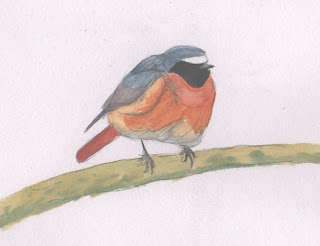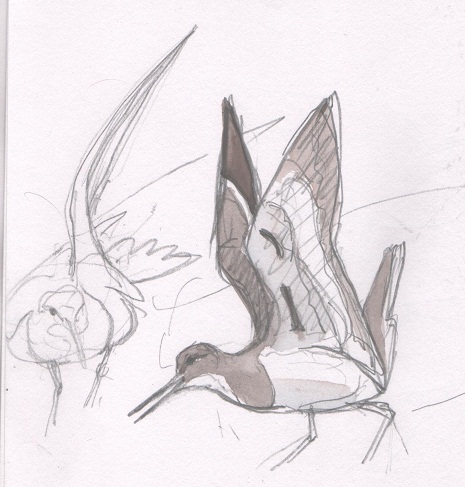Drawings, sketches and paintings of wildlife encountered on travels locally and further afield.
Monday, 29 April 2013
Sunday, 28 April 2013
Redstart. Padley Gorge. Brief views of these flighty, elusive birds after a full day trekking around the site. They favoured a particular area along the edge of the wood. I saw a pair (male and female)perched on the drystone wall. Earlier I saw a male fleetingly from deep within the wood itself.
The Redstarts were mainly located by their characteristic alarm call which at times sounded very faint even though the bird was only a few feet away. I heard some snatches of song though I think the weather wasnt condusive to singing.
Pied Flycatcher. Padley Gorge. A typical view of this bird. Though I saw at least 6 birds (including a couple of females) during my visit I found them incredibly hard to sketch as they never sat still longer than a few seconds and would shoot off behind the trees at the slightest movement. They did, however, make themselves known with loud song and alarm calls and would never stray far from a favoured nest box or tree-hole. I heard the meerest snippet of Wood Warbler song but will have to wait to add that one to the blog! Lots of Nuthatch; male and female Great-spotted Woodpecker; dozens of Treecreepers; Grey Wagtail and lots of the commoner species.
The Redstarts were mainly located by their characteristic alarm call which at times sounded very faint even though the bird was only a few feet away. I heard some snatches of song though I think the weather wasnt condusive to singing.
Pied Flycatcher. Padley Gorge. A typical view of this bird. Though I saw at least 6 birds (including a couple of females) during my visit I found them incredibly hard to sketch as they never sat still longer than a few seconds and would shoot off behind the trees at the slightest movement. They did, however, make themselves known with loud song and alarm calls and would never stray far from a favoured nest box or tree-hole. I heard the meerest snippet of Wood Warbler song but will have to wait to add that one to the blog! Lots of Nuthatch; male and female Great-spotted Woodpecker; dozens of Treecreepers; Grey Wagtail and lots of the commoner species.
Sunday, 21 April 2013
Corn Bunting. Barton-in-fabis. Calling from the top of a tall roadside tree. Thanks to Rob Hoare for locating and protecting these declining birds.
The Corn Bunting's call is said to sound like someone rattling a bunch of keys.
To me it has a metallic crunch quality very distinctive and evocative. Would be a massive shame if it were to disappear.
Wheatear. Field by Beeston Weir. Watching me from the middle of a field of young plants. At one point I saw its throat moving as if it were singing though it was too far away to hear.
Blackcap. Clifton Wood. Lots of singing Blackcaps in the woodland understorey by the river. This bird has a metal ring on its leg. Another one I watched had a beakful of dry grass but still couldnt stop singing!
Buzzard. Branshill. Sat on this post for some minutes constantly turning head to scan its surroundings. The wind had developed and the Buzzard angled itself for least resistance.
Common Sandpipers, Beeston Weir. Sighted on the 20th April. Two birds here mid morning and for much of the time foraged peacefully at the waters edge where stones and gravel have created a beach-like area. Occasionally the two birds paths crossed which caused a lot of posturing with wings up and chasing each other calling loudly. This was beautiful to watch but it came to an abruptend by the arrival of three youths loitering on the bank.
Sunday, 14 April 2013
Thursday, 11 April 2013
Wednesday, 10 April 2013
Tuesday, 9 April 2013
Saturday, 6 April 2013
Thursday, 4 April 2013
Avocet. Attenborough. Standing at the screen overlooking the wader scrape, two birdwatchers casually asked if I had seen the Avocet! Almost disbelieving them I located the bird and hurriedly got the sketchbook out but moments later an immature Black headed Gull chased the wader off and I thought it had gone - without getting any sketches. After a few minutes I scanned the area to find it had returned to the same place and was busily feeding. It swam for the majority of time and up-ended like a duck frequently, kicking its legs out. The Gull constantly followed and harrassed the feeding bird at every opportunity. The wind was savage blowing directly into my face from the east and numbed my hands and face. After a while the Avocet swam to an island and slept, its black and white plumage tinged pink by the sun.
Wednesday, 3 April 2013
Green Woodpecker. Thompson's Wood, Wollaton. Sat at the top of a Sycamore and hardly moved as the tree swayed in the strong wind before flying off through the trees towards the lake. The lack of red below the eye makes this a female bird.
Female Goosander swimming up the Trent at Attenborough. It dived frequently gradually increasing the distance between itself and me.
Bittern. Attenborough, wet marsh. Walking back to the car I took the wet marsh path and scanned the reeds on the opposite side. This turned out to be an amazingly lucky moment as I caught sight of a Bittern moving slowly along the edge behind a screen of reeds. I watched it for a good ten minutes before it disappeared into thicker reeds.
Female Goosander swimming up the Trent at Attenborough. It dived frequently gradually increasing the distance between itself and me.
Monday, 1 April 2013
Black headed Gulls resting. Part of a large flock of Black-heads at Bennerley most of which had heads tucked back and were sleeping. Amongst the flock were a few Common Gulls and 1 or 2 Lesser Black Backs. Teal dabbled at the edge of the flood pool.
Red Deer in the sun. The sun decided to show itself later in the afternoon so I visited Wollaton where the Red Deer stags were gathered around the sugar beet all laying down in the sun.
Red Deer studies. All the younger stags still have their antlers. The older males who shed their antlers a few weeks ago are beginning to grow new antlers already.
Red Deer in the sun. The sun decided to show itself later in the afternoon so I visited Wollaton where the Red Deer stags were gathered around the sugar beet all laying down in the sun.
Red Deer studies. All the younger stags still have their antlers. The older males who shed their antlers a few weeks ago are beginning to grow new antlers already.
Subscribe to:
Comments (Atom)





























